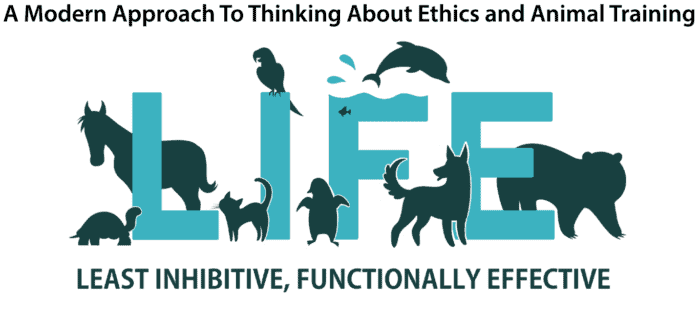It’s now been over 20 years since Stephen Lindsay introduced the idea of LIMA (Least Intrusive and Miminally Aversive) within the concept of cynopraxis. A few years ago, a number of animal-related organizations adopted and endorsed LIMA. However, nearly all of them put together their very own, abbreviated definition, omitting the background which helped define it.

Now, a few years later still, this Shelter Playgroup Alliance tried coming out with something they claim is even better. As I used to run municipal shelter playgroups, I followed this group for a few years now. Although for many years now the established methods and approaches used by Aimee Sadler in Dogs Playing for Life were pretty close to what I had been doing, this so-called alliance seemed to feel they knew better. However, I never saw any indication of that being true, and their poor endorsement here seems to support that.
What they say about LIFE
The Least Inhibitive, Functionally Effective (LIFE): A Modern Approach to Ethical Animal Training Methods was developed and presented by Dr. Eduardo J. Fernandez, PhD. School of Animal and Veterinary Sciences, The University of Adelaide (Australia).
https://www.shelterdogplay.org/life-webinar

On LIMA, Dr. Fernandez then says:
The Least Intrusive, Minimally Aversive (LIMA) approach to animal training has encompassed an ethical standard for modern force-free animal trainers. Originally developed by Steven R. Lindsay in 2005, LIMA has been used to emphasize greater choice and control for animals while limiting the use of coercion in behavior management practices. Nonetheless, a number of problems were built into the creation of LIMA and continue to exist today, including (a) a lack of clarity in its terminology, (b) ambiguity in desired training approaches, and (c) a history of permitting aversive training techniques, including the use of shock collars.
Starting at the beginning, LIMA is simply least intrusive and minimally aversive. Two very simple and clear statements. However, LIFE is least inhibitive; wait a minute, what the heck does that even mean? Then Functionally Effective, which seems to simply mean anything that works. And what world would you come from to claim that to be increased clarity?
As for ambiguity in training approaches, a very large part of any approach is in how it’s applied and the intensity, which LIMA addresses, but LIFE does not.
As for LIMA being an ethical standard for (sic) modern force-free training, that is complete nonsense. In Force Free and the Professionals I examine several representative cases and explain where they are quite lacking. For that matter, most force-free training I’ve seen violates LIMA.
As to permitting aversive training techniques, it has been repeatedly shown that anybody who excludes all aversives is woefully ignorant of both natural biological development and basic behavioral psychology. That it is the intensity and duration during that which matters, as you can readily see just by observing nature. That there is a very significant difference between a mother forcefully controlling a young pup, and a bear ripping an animal’s head off.
An alternative approach is thus proposed, and one that specifies (1) an inhibitory effect on behaviors to be avoided, (2) the importance in identifying function for behavior change procedures, and (3) the use of effectiveness as a practical metric for training success.
Firstly, is that avoiding any inhibitory effect on behaviors, or producing an inhibitory effect on those behaviors which you desire to avoid? If I return to Steven Lindsay and LIMA, Lindsay writes in very clear and concise statements. Here, however, Fernandez writes in an ambiguous manner. Looking at each of his three items, none of them is clear.
The result is the Least Inhibitive, Functionally Effective (LIFE) approach to animal training methods. LIFE is discussed in terms of the importance of established behavioral principles, terminology, and procedures, as well as its ability to promote optimal welfare for the animals under our care and in our lives.
What? That says if the dog listens and learns you won’t beat him with a club? And, since when and where did he define the phrase negative welfare? Because without that, his positive welfare makes no sense at all.
But, let’s now take a look at their three, more detailed explanations in their framework document.
Increase meaningful choices
Least inhibitive means removing choice restrictions to increase quality of life.
Avoid environmental restrictions to motivate behavior, such as food deprivation.
Improve meaningful options by expanding response alternative and behavioral repertoires.
But, what makes some choices more meaningful than others? Why would removing choice restriction increase quality of life? With appropriate scenarios, why wouldn’t that go in either direction, such as permitting the dog to pursue a dangerous activity?
Next, they avoid starving the dog. But environmental restrictions would also include fences to keep the dog from running away. And, or course, you can no longer give food rewards.
And the last one is pure gobbledygook, classed as what is called a feel-good statement which has no real significance. Neither of those options is anywhere qualified as being beneficial as opposed to harmful, such as chasing a rabbit across the street against traffic due to lack of inhibition.
Identify behavioral functions
Assess cause of a behavior so that we can directly connect them to behavior change plans.
Collect data based on observations and behavior change manipulations.
Match causes of a behavior so that we can directly connect them to behavior change plans.
The first one here is probably the single most important reason why most dog training methods will fail. Page after page has been written about how typical people incorrectly guess the cause of a behavior. And how any two dogs trainers can only agree that a third one is wrong.
And this is not just educating people, but also getting them to really think about cause and effect.
As for their collecting data, most dog trainers will first ask the person to describe the issue and history. Then, upon their first visit, they immediately see the person had little success because much of what they collected was simply wrong. That their description really didn’t fit was actually happened. A very common example here is the so-called protective dog.
As for matching causes of a behavior, just what are you matching them against? This is not a computer, but a dog. The exact same behavior could have several causes, and this could change over time. And just how much of what is included in the cause? I used to teach learning behavioral sequences, and showed that altering just one component may radically change the result. And that then measuring the dog’s sensitivity to various stimuli helped determine how to best change it. Instead, he wants to take an incomplete and likely incorrect behavior cause and somehow magically determine how to change that?
Maximize training success
Effectiveness is only one component of success. Impact of training on welfare is also important.
Consider other welfare impacts, such as context and human-animal interactions.
Training success includes positive welfare during and after training sessions.
If I took their welfare as meaning how happy both the dog and the person seem with the results, then wouldn’t that be the definition of effectiveness? I mean, wouldn’t claiming the dog would sit or do something on command as effective would be just playing with words and quite silly?
Overall, this seems to claim that doing some ambiguous and abstract things may produce some undefined optimal welfare. And that if we were to go back and look at the very roots of the main problems which people have had in training dog behavior, we would find them being completely ignored. Instead, he just says that people should do what they have not done and don’t know how to do, and all will be well.
As for being better than LIMA, the same problems remain. Over the decades I have seen a number of groups (finally) embrace LIMA, but do so by spreading around some watered-down interpretation, omitting the background on which it sits. Of course, Dr. Fernandez’s opinion on that is somewhat different.
On their webinar
Turning to the webinar, one advantage of that to the author is that reviewing the detail often takes three or more times longer than the actual webinar. First, you have to slowly scan through, stopping to note times and a brief label. Then, go back to each time mark, make notes, and any quotes require you to type out the text he is speaking. Enough work that most people who disagree would give no more than a few brief comments.
Fernandez himself then identifies his approach as a force-free and says that is equivalent to positive reinforcement reward training, which is quite untrue. However, there’s a good reason why force-free training does not exist in nature. And I have found many to be actually using far too much force for my taste. Of course, pointing out things and mentioning that to them did not go well. Unlike LIMA, Fernandez is now placing himself at an extreme view.
Of course, not only nature, but also basic psychology says that positive reinforcement alone is not a panacea. That practically all complex training scenarios of any type will include components of all four operant quadrants, differing only in duration and intensity.
Fernandez then speaks about ethics arising from World War II, sort of omitting human behaviors for thousands of years and cultural differences. A bit of rambling here, and in his discussing problems with LIMA, Fernandez (at 20:30 in the video) calls LIMA’s use of intrusive as:
something that clowns do in your dreams.
Well, that most certainly offered us a logical and science-based rational explanation! And, with over an hour of additional rambling to follow, I decided to stop taking notes on his webinar.
In summation
This is yet another feel-ggod attempt to gain popularity for his view. Here, most of Dr. Fernandez’s view are verbal. Alternately, for LIMA, Stephen Lindsay’s views are well expressed in three volumes and several thousand pages. A view that is logically organized, and indexed to allow detailed study.
Nowhere have I seen Dr. Fernandez give any more than his own opinion on his views. Nor do I see any clear definition for much of what he says here. Perhaps my biggest question is if this Shelter Playgroup Alliance actually read this? If so, I certainly wouldn’t trust their reading skills elsewhere.

You defend LIMA how it is part of Cynopraxic ethics and not meant to stand alone. You tell the truth about those other groups appropriating LIMA and distorting its meaning. You defend what’s real about learning and dogs.
You counter his every argument and it seems to have no where to go. It becomes nonsense. You’re generous in giving your time and intelligence to help clear the air. Thank you. Peter